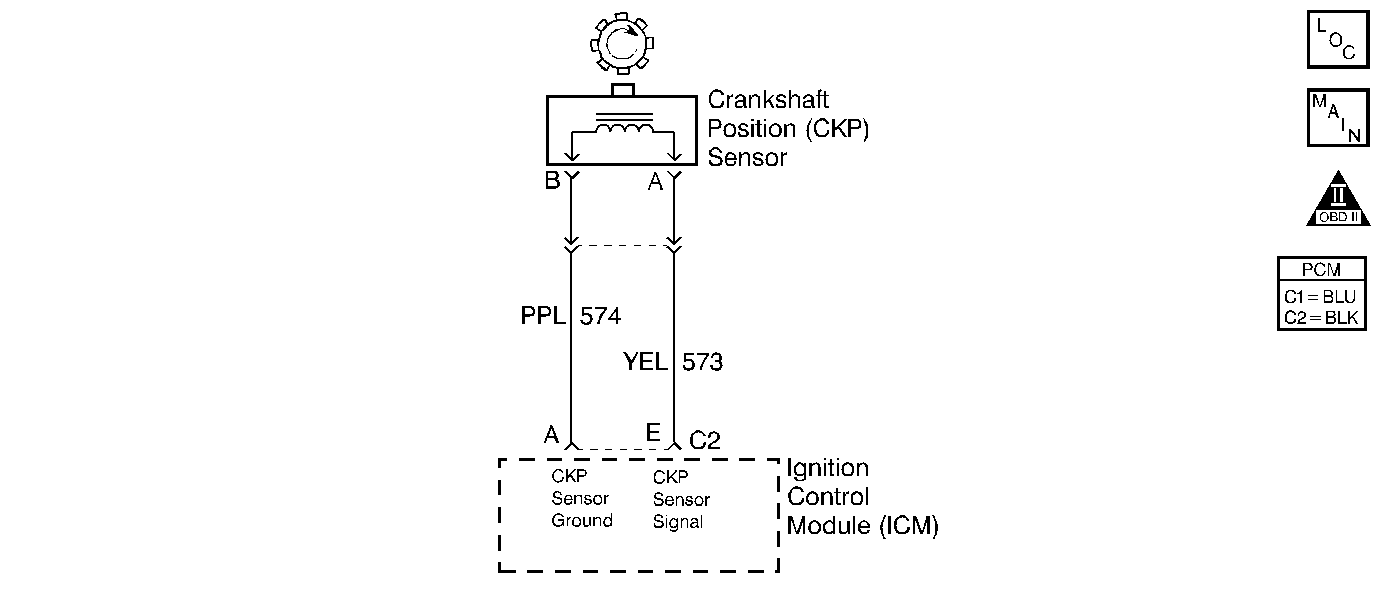
Circuit Description
The electronic ignition control module (ICM) sends a reference signal to the powertrain control module (PCM) seven times per crankshaft revolution to indicate crankshaft position and RPM so that the PCM can determine when to pulse the ignition coils and control the ignition timing. This signal is called medium resolution (7X reference) because it occurs seven times per crankshaft revolution. The ICM applies 5 volts through the 7X reference circuit and, in effect, switches this circuit to ground for a very short period of time. The seventh pulse is the sync pulse and is used for crankshaft position (CKP) reference.
Conditions For Running The DTC
| • | Engine running |
| • | No active ECT DTCs |
| • | No active TP DTCs |
Conditions for Setting the DTC
The CKP (7X) resync counter goes more than 15 counts within 256 seconds.
Action Taken When the DTC Sets
| • | The control module illuminates the malfunction indicator lamp (MIL) if a failure is detected during 2 consecutive key cycles. |
| • | The control module will set the DTC and records the operating conditions at the time the diagnostic fails. The control module stores the failure information in the scan tools Freeze Frame and Failure Records. |
Conditions for Clearing the MIL/DTC
| • | The control module turns OFF the MIL after 3 consecutive drive trips when the test has run and passed. |
| • | A history DTC will clear if no fault conditions have been detected for 40 warm-up cycles (coolant temperature has risen 22°C (40°F) from the startup coolant temperature and the engine coolant temperature is more than 70°C (158°F) during the same ignition cycle). |
| • | Use a scan tool to clear the DTCs. |
Diagnostic Aids
| • | If the complaint was Cranks But Will Not Run, the DTC P0335 may set when attempting to start the engine more than 15 times and the ignition is not turned OFF between the attempts. |
| • | A defective reluctor wheel can result in an intermittent. Remove the crankshaft sensor and inspect the reflector wheel through the hole. Inspect the porosity and condition of the wheel. |
An intermittent may be caused by any of the following conditions:
| • | A poor connection |
| • | Rubbed through wire insulation |
| • | A broken wire inside the insulation |
Thoroughly inspect any circuitry that is suspected of causing the intermittent complaint. Refer to Testing for Intermittent Conditions and Poor Connections in Wiring Systems.
If a repair is necessary, refer to Wiring Repairs or Connector Repairs in Wiring Systems.
Test Description
The numbers below refer to the step numbers on the diagnostic table:
Step | Action | Values | Yes | No | ||||||||
|---|---|---|---|---|---|---|---|---|---|---|---|---|
1 | Did you perform the Powertrain On-Board Diagnostic (OBD) System Check? | -- | ||||||||||
2 | Attempt to start the engine. Does the engine start and run? | -- | ||||||||||
3 | Visually inspect the wiring harness of the CKP sensor including the CKP reference signal circuit from the ICM to the PCM for improper routing near high voltage circuits, all other circuitry or for contacting any metal surface and moving components. Did you find and correct any condition? | -- | ||||||||||
|
Caution: Avoid contact with moving parts and hot surfaces while working around a running engine in order to prevent physical injury. With the engine running, wiggle the harness connectors of the following components and related circuits, while listening for the engine to stumble:
Does the engine stumble? | -- | Go to Diagnostic Aids | ||||||||||
5 |
Did you find and correct the condition? | -- | ||||||||||
6 |
Did you find and correct the condition? | -- | ||||||||||
7 |
Did you find and correct the condition? | -- | Go to Diagnostic Aids | |||||||||
8 |
Does the DTC reset? | -- | System OK |
